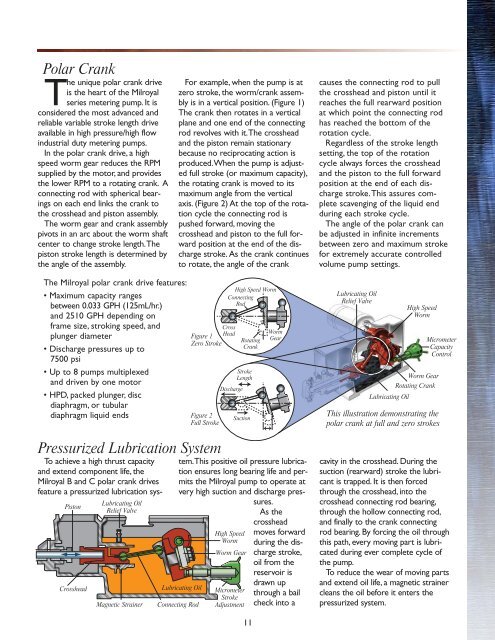Metering Pump Technology - Fine Line Instrument
Metering Pump Technology - Fine Line Instrument
Metering Pump Technology - Fine Line Instrument
Create successful ePaper yourself
Turn your PDF publications into a flip-book with our unique Google optimized e-Paper software.
Polar Crank<br />
The unique polar crank drive<br />
is the heart of the Milroyal<br />
series metering pump. It is<br />
considered the most advanced and<br />
reliable variable stroke length drive<br />
available in high pressure/high flow<br />
industrial duty metering pumps.<br />
In the polar crank drive, a high<br />
speed worm gear reduces the RPM<br />
supplied by the motor, and provides<br />
the lower RPM to a rotating crank. A<br />
connecting rod with spherical bearings<br />
on each end links the crank to<br />
the crosshead and piston assembly.<br />
The worm gear and crank assembly<br />
pivots in an arc about the worm shaft<br />
center to change stroke length.The<br />
piston stroke length is determined by<br />
the angle of the assembly.<br />
The Milroyal polar crank drive features:<br />
Maximum capacity ranges<br />
between 0.033 GPH (125mL/hr.)<br />
and 2510 GPH depending on<br />
frame size, stroking speed, and<br />
plunger diameter<br />
Discharge pressures up to<br />
7500 psi<br />
Up to 8 pumps multiplexed<br />
and driven by one motor<br />
HPD, packed plunger, disc<br />
diaphragm, or tubular<br />
diaphragm liquid ends<br />
To achieve a high thrust capacity<br />
and extend component life, the<br />
Milroyal B and C polar crank drives<br />
feature a pressurized lubrication sys-<br />
Piston<br />
Crosshead<br />
Lubricating Oil<br />
Relief Valve<br />
Magnetic Strainer<br />
For example, when the pump is at<br />
zero stroke, the worm/crank assembly<br />
is in a vertical position. (Figure 1)<br />
The crank then rotates in a vertical<br />
plane and one end of the connecting<br />
rod revolves with it.The crosshead<br />
and the piston remain stationary<br />
because no reciprocating action is<br />
produced.When the pump is adjusted<br />
full stroke (or maximum capacity),<br />
the rotating crank is moved to its<br />
maximum angle from the vertical<br />
axis. (Figure 2) At the top of the rotation<br />
cycle the connecting rod is<br />
pushed forward, moving the<br />
crosshead and piston to the full forward<br />
position at the end of the discharge<br />
stroke. As the crank continues<br />
to rotate, the angle of the crank<br />
tem.This positive oil pressure lubrication<br />
ensures long bearing life and permits<br />
the Milroyal pump to operate at<br />
very high suction and discharge pressures.<br />
As the<br />
crosshead<br />
Lubricating Oil<br />
Connecting Rod<br />
Cross<br />
Figure 1<br />
Head<br />
Zero Stroke<br />
Figure 2<br />
Full Stroke<br />
Pressurized Lubrication System<br />
High Speed Worm<br />
Connecting<br />
Rod<br />
Discharge<br />
High Speed<br />
Worm<br />
Worm Gear<br />
Micrometer<br />
Stroke<br />
Adjustment<br />
Rotating<br />
Crank<br />
Stroke<br />
Length<br />
Suction<br />
11<br />
Worm<br />
Gear<br />
moves forward<br />
during the discharge<br />
stroke,<br />
oil from the<br />
reservoir is<br />
drawn up<br />
through a bail<br />
check into a<br />
causes the connecting rod to pull<br />
the crosshead and piston until it<br />
reaches the full rearward position<br />
at which point the connecting rod<br />
has reached the bottom of the<br />
rotation cycle.<br />
Regardless of the stroke length<br />
setting, the top of the rotation<br />
cycle always forces the crosshead<br />
and the piston to the full forward<br />
position at the end of each discharge<br />
stroke.This assures complete<br />
scavenging of the liquid end<br />
during each stroke cycle.<br />
The angle of the polar crank can<br />
be adjusted in infinite increments<br />
between zero and maximum stroke<br />
for extremely accurate controlled<br />
volume pump settings.<br />
Lubricating Oil<br />
Relief Valve<br />
High Speed<br />
Worm<br />
Worm Gear<br />
Rotating Crank<br />
Lubricating Oil<br />
This illustration demonstrating the<br />
polar crank at full and zero strokes<br />
Micrometer<br />
Capacity<br />
Control<br />
cavity in the crosshead. During the<br />
suction (rearward) stroke the lubricant<br />
is trapped. It is then forced<br />
through the crosshead, into the<br />
crosshead connecting rod bearing,<br />
through the hollow connecting rod,<br />
and finally to the crank connecting<br />
rod bearing. By forcing the oil through<br />
this path, every moving part is lubricated<br />
during ever complete cycle of<br />
the pump.<br />
To reduce the wear of moving parts<br />
and extend oil life, a magnetic strainer<br />
cleans the oil before it enters the<br />
pressurized system.


